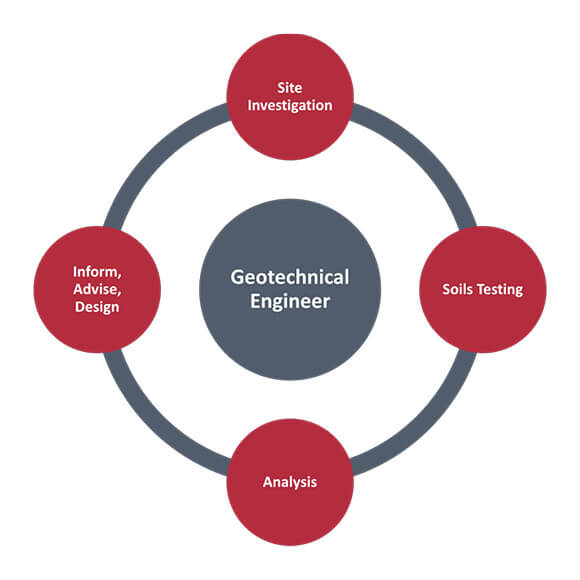Geotechnical Engineering For Construction Projects Can Be Fun For Anyone
Table of ContentsAll About Geotechnical Engineering For Construction ProjectsFacts About Geotechnical Engineering For Construction Projects RevealedAbout Geotechnical Engineering For Construction ProjectsThe Main Principles Of Geotechnical Engineering For Construction Projects The 5-Minute Rule for Geotechnical Engineering For Construction ProjectsThe Ultimate Guide To Geotechnical Engineering For Construction Projects
The function of geotechnical engineering significantly deals with realizing the attributes of dirt and rock, which may vary considerably by their density, wetness material etc. These attributes need to be checked out by geotechnical designers to forecast their activities under different scenarios. The safety and security as well as stability of structures are affected by soil problems, making this evaluation necessary., in addition to just how they engage with constructions that have been put up on or within them, is one of the key descriptions for why geotechnical engineering is vital.
Along with structural planning and construction, geotechnical design is additionally important to the restoration and upkeep of pre-existing frameworks. Age-related destruction or additional problems could impact a structure's stability and effectiveness. Environmental protection is achieved via geotechnical engineering. Know-how in air, water, and soil quality maintenance is placed to make use of by geotechnical designers to minimize the negative impacts of jobs.
To sum up, geotechnical engineering is a vital technique that preserves the durability and stability of civil facilities. Geotechnical engineers add to making building tasks reliable all over the world by comprehending the behaviour of planet materials and using suitable planning techniques.
Geotechnical Engineering For Construction Projects Can Be Fun For Anyone
By examining dirt, rock, and subsurface problems, geotechnical designers provide necessary insights that help in the design, building, and upkeep of buildings and framework.

Getting The Geotechnical Engineering For Construction Projects To Work
Lab testing: Identifying the homes of soil and rock. Area screening: Performing tests on-site to analyze conditions. Analysis and style: Using data to design foundations, preserving walls, passages, and various other frameworks. Numerous top-level building jobs have actually efficiently utilized geotechnical design to ensure their security and security. For example:: The world's tallest structure needed a deep understanding of the underlying geology.
As a leader in geotechnical design, BECC Inc. is devoted to supplying More about the author cutting-edge and efficient remedies that satisfy the greatest standards of high quality and safety and security. For more details on how BECC Inc. can support your next building task, call us today and let us aid you improve strong ground.
William Rankine, a designer and physicist, created a different to Coulomb's earth stress theory. Albert Atterberg developed the clay uniformity indices that are still used today for soil classification. In 1885, Osborne Reynolds identified that shearing causes volumetric expansion of thick materials and contraction of loose granular materials. Modern geotechnical design is claimed to have begun in 1925 with the publication of Erdbaumechanik by Karl von Terzaghi, a mechanical designer and geologist.
Fascination About Geotechnical Engineering For Construction Projects
Terzaghi also created the framework for theories of birthing capability of foundations, and the concept for forecast of the rate of negotiation of clay layers because of combination. Later on, Maurice Biot totally developed the three-dimensional soil combination theory, prolonging the one-dimensional version formerly established by Terzaghi to extra general hypotheses and presenting the set of standard equations of Poroelasticity.
Geotechnical engineers explore and determine the properties of subsurface conditions and materials.
See This Report about Geotechnical Engineering For Construction Projects
Still, they are often made use of to enable a rock hound or designer to be reduced into the borehole for direct aesthetic and manual exam of the dirt and rock stratigraphy. Various soil samplers exist to meet the needs of various design jobs. The conventional infiltration examination, which makes use of a thick-walled split spoon sampler, is the most usual method to gather disturbed samples.

Commonly, the interface's specific geometry is unidentified, and a simplified interface geometry is presumed. Finite slopes need three-dimensional models to be analyzed, so most slopes are evaluated thinking that they are considerably large and can be stood for by two-dimensional models.
Our Geotechnical Engineering For Construction Projects PDFs
The empirical technique might be described as complies with: General exploration enough to develop the harsh nature, pattern, and properties of down payments. Assessment of the additional info most probable conditions and one of the most undesirable imaginable variances. Producing the style based upon a functioning theory of habits expected under the most probable problems. Option of amounts to be observed as building profits and calculating their prepared for values based upon the functioning hypothesis under the most unfavorable conditions.
Dimension of quantities and assessment of actual conditions. Design alteration per real problems The empirical technique appropriates for building and construction that has currently begun when an unanticipated growth takes place or when a failing or crash looms or has already occurred. It disagrees for projects whose design can not be modified throughout building.